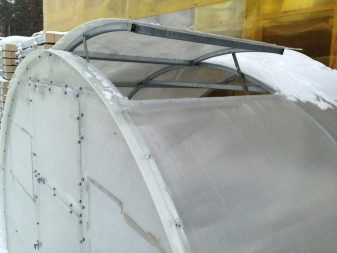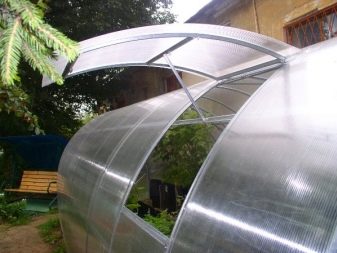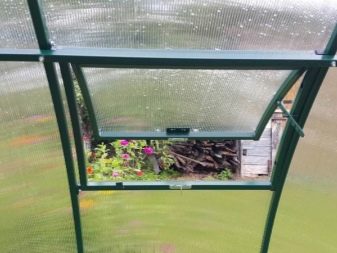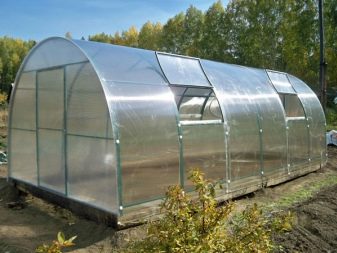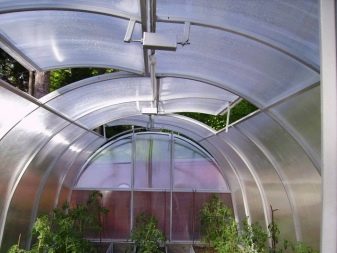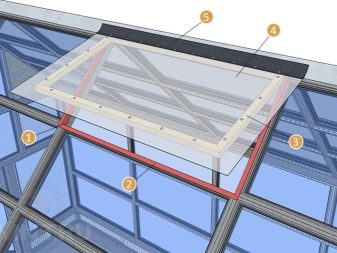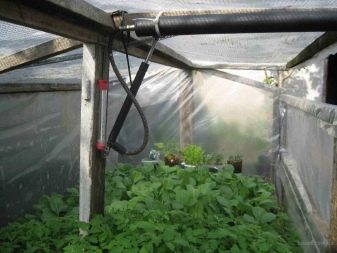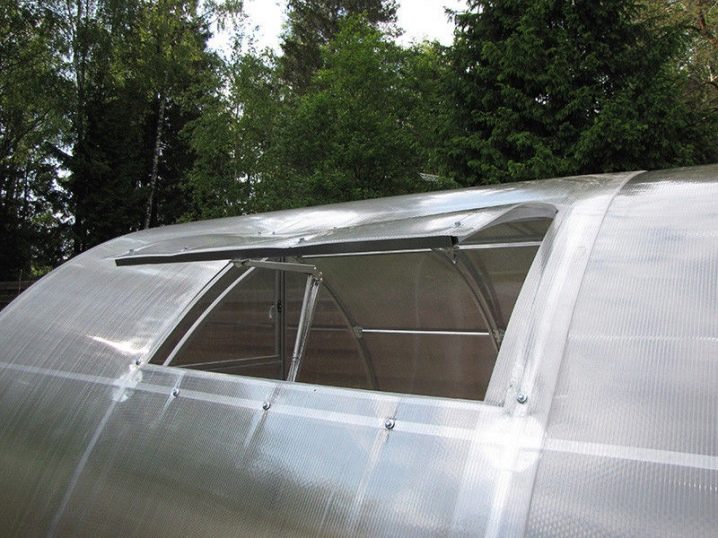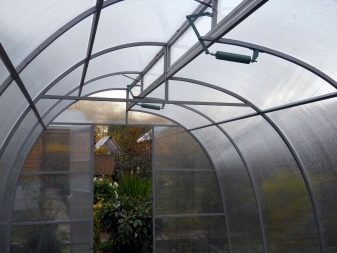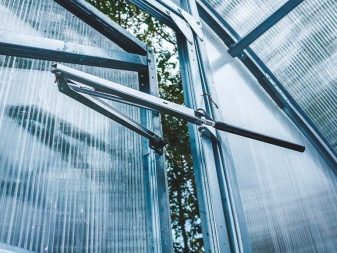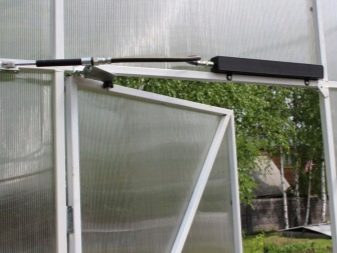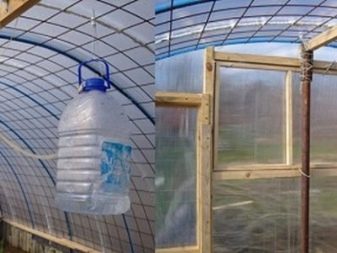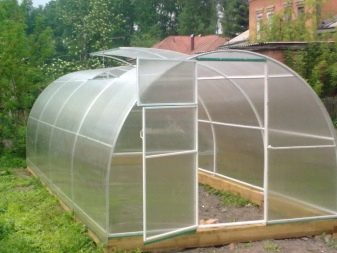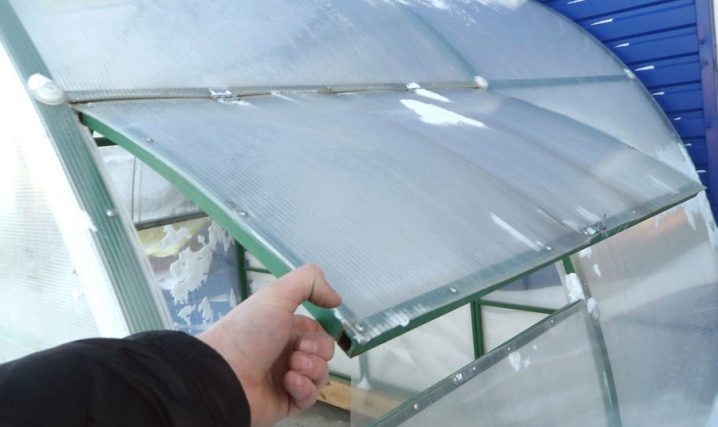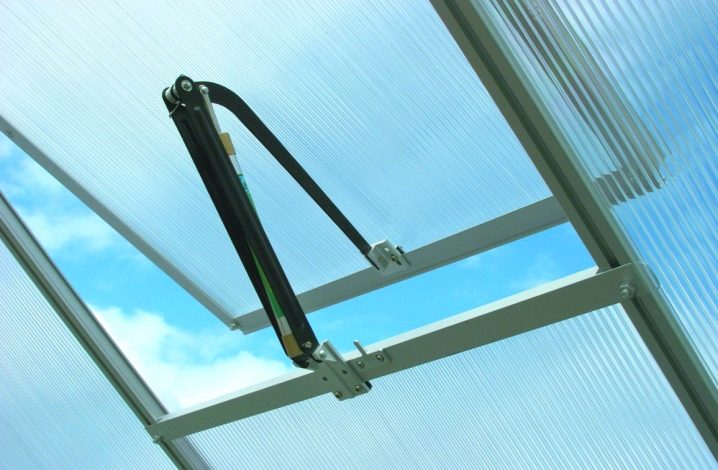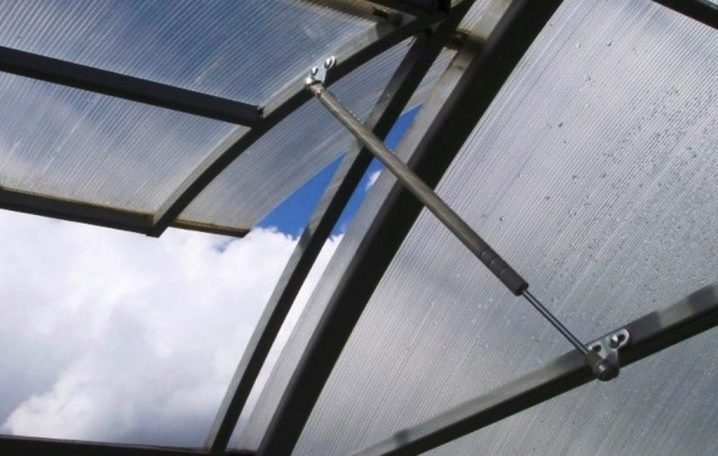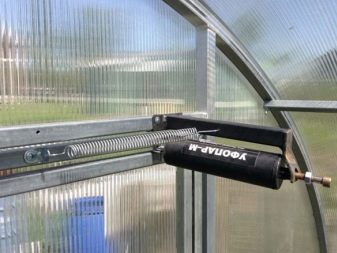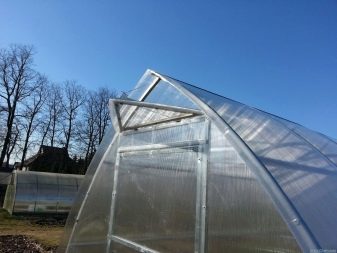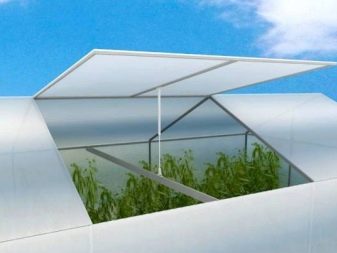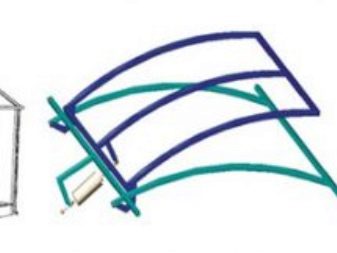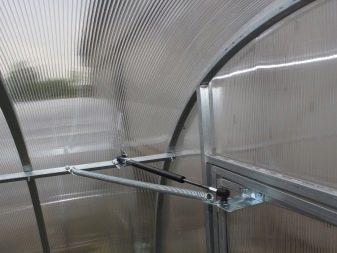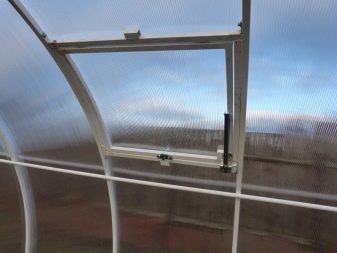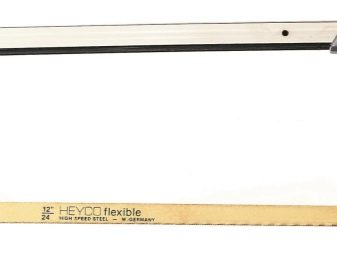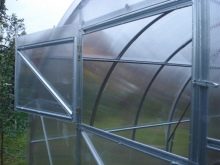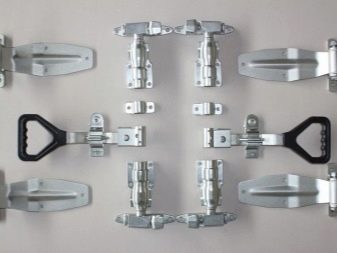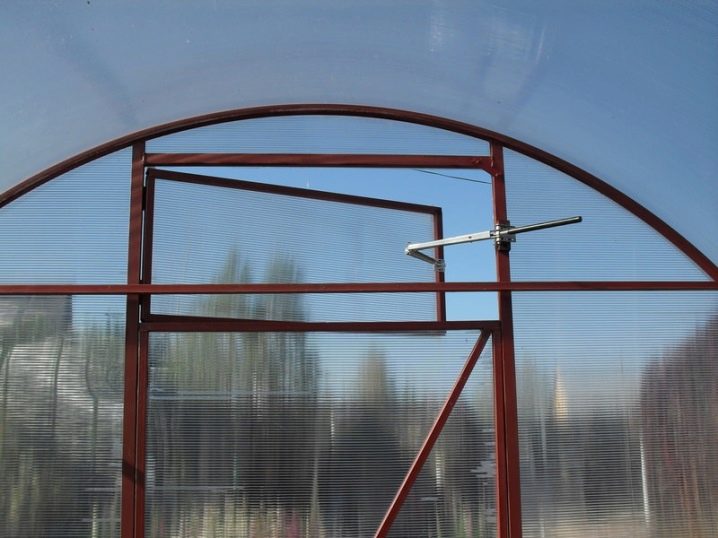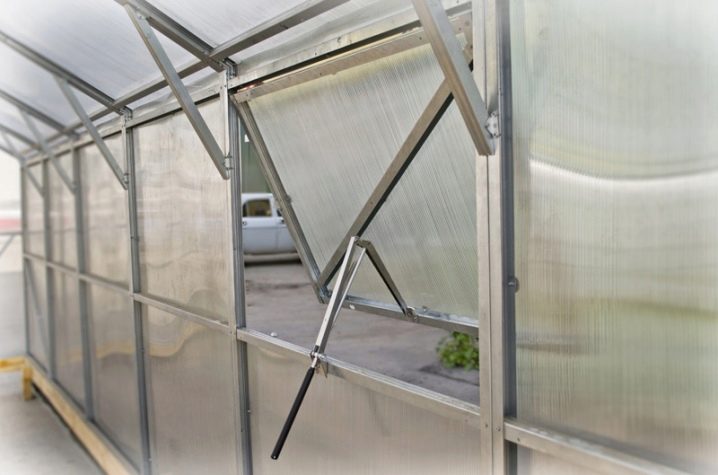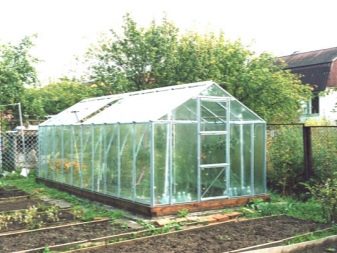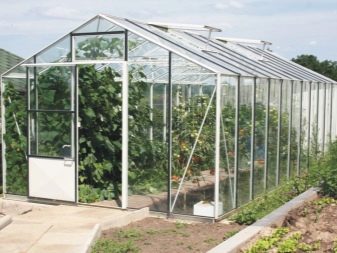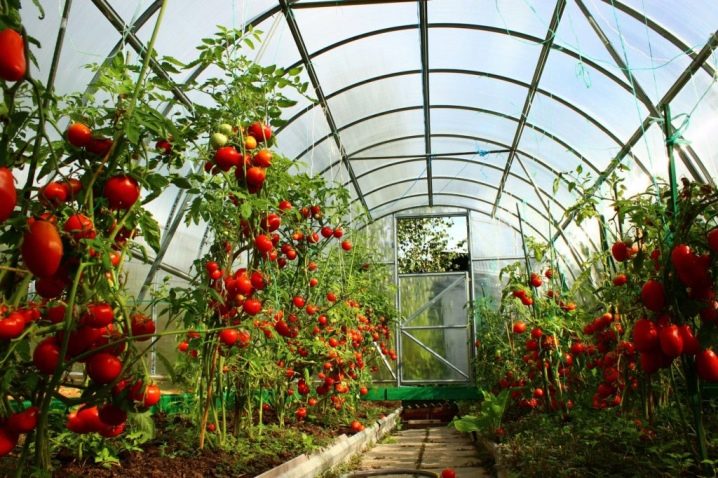Features of the device vents for greenhouses
In order to obtain a high yield in the greenhouse, it is necessary to ensure the correct mode of ventilation. The window will cope well with this task. Such a design should be of high quality and highly efficient. To achieve this result, you should be familiar with the features of the device vents for greenhouses.
Special features
Cottages, equipped with greenhouses, always pleased their owners with a great harvest. In winter, in polycarbonate greenhouses, which are currently the most popular, the conditions for plant maintenance are optimal. But with increasing solar activity in the spring and summer, the situation changes.
Polycarbonate transmits light very well, but at the same time does not allow air to circulate.
The temperature in the greenhouse becomes too high and can have a detrimental effect on the plants grown in it. Therefore, in this design, the vent is especially important.
The movable part of the greenhouse, intended for ventilation, is called a vent. This device allows you to create your own microclimate in the greenhouse, which has a beneficial effect on the cultivation of various kinds of vegetable crops.
The window has the following features:
- prevents the risk of condensation;
- ensures the correct movement of air masses;
- eliminates strong overheating of air in the greenhouse during the day;
- minimizes temperature differences between day and night;
- will allow the adaptation of plants before planting in open ground.
The window in the greenhouse will not allow the appearance of wood lice, aphids, slugs, all sorts of pests and bacteria, which always appear in warm and humid rooms. Greenhouses, in which the indicated conditions are observed, will delight with an excellent harvest.
Device
The arrangement of the vents in greenhouses may differ in size, location and opening mechanism. The latter characteristic is the most significant.For the organization of good air circulation can use natural or forced type of ventilation.
In a film or glass greenhouse, made on its own, usually use the simplest and cheapest way to equip the greenhouse with the correct microclimate - natural ventilation. Natural ventilation involves the provision of ventilation through open doors, windows, air vents. The overheated and humid air of the greenhouse is gradually replaced by street, more fresh.
Given that hot air tends to rise, you should equip the window on the roof, and the lateral location of the door will provide air flow.
Such ventilation sufficiently provides good conditions in a small greenhouse, but requires mandatory monitoring by the person. However, for large greenhouses such ventilation will not be enough.
For large greenhouses, forced ventilation is provided. Such ventilation is equipped with a fan. An exhaust fan is installed at the top of the structure, the power of which should be sufficient to effectively eliminate hot air.Devices for air flow installed on the walls, given the location of the plants. Direct flow of colder air masses can harm them. This airing device is most often used in addition to natural ventilation and does not exclude human control.
The complete absence of manual adjustment of the microclimate in the greenhouse will be able to provide an automatic ventilation system.
Automation
Automatic systems that provide ventilation in the greenhouse are divided into the following categories:
- hydraulic;
- bimetallic;
- electric.
Hydraulic
Automatic opening of the vents on the hydraulic drive is reliable. This lever system can be purchased in the store or do it yourself.
The principle of operation of the mechanism is based on the ability of liquids to expand when heated. Factory devices include a hydraulic cylinder with liquid (paraffin or oil) and a movable rod attached to the vent window. When the air in the greenhouse is heated, the liquid in the hydraulic cylinder expands and pushes out the rod, which gradually opens the vent. The air is cooled, the liquid narrows and the vent closes.
A DIY system works like communicating vessels.
One of the vessels is located below and acts as a thermostat. It is airtight, half filled with liquid, half air. Another vessel is located at the top and performs the function weighting. The flap should be fixed on the rotating central axis. On one side of the sash weighting is established, on the other - a counterweight.
When the temperature in the greenhouse rises, the air in the lower vessel expands and pushes the liquid into the upper vessel, and the vent opens. When the temperature in the greenhouse decreases, the system works in the reverse order and the window is closed.
This design can be done using ordinary plastic bottles.
This is the simplest, but at the same time effective automatic system for opening the vents. To create it, a minimum of effort and materials is expended.
The disadvantage of this system is a long cooling liquid. With a cold snap, the window will close for about 20-30 minutes. Hypothermia can be disastrous for cucumbers and other crops that do not tolerate cold.
Bimetallic
Bimetallic ventilators consist of two metal plates with a different rate of expansion when heated. The hot air in the greenhouse heats the plates and one of them is curved in an arc, opening the flap flaps. When the air cools, the metal returns to its original state and the device closes.
To make the most bimetallic automation is quite simple. Materials that are required for the manufacture can always be found at the dacha. You will need two metal plates: vinyl plastic and roofing iron. They stick together among themselves. One end is fixed, and the second is connected with the stem window leaf. The result is a good automatic system. The only drawback of this drive is a small power level, so it is suitable only for lightweight structures.
Electric
Electric type of ventilation is equipped with temperature relays and fans. When air overheats, the relay is activated and turns on the hood. This system is powerful, compact, reacts quickly to temperature differences. A significant disadvantage is the dependence on electricity.If this type of ventilation is used in the greenhouse, purchase of backup power sources will be required.
To protect plants from overheating, in the event of a power outage, will help the use of alternative energy sources (solar panels, wind power). Due to the need to purchase additional items, these systems are expensive. But it is possible to choose the power of the electric motor. For heavier structures will have to spend money on a strong drive, and for lightweight thin ones will do.
Dimensions
To properly organize the ventilation in the greenhouse, it is necessary to correctly calculate the size and number of vents. The area of the openings with shutters should be 20-30% of the floor area in the greenhouse. Experts advise to have one ventilator for every two meters.
Greenhouses measuring 3x6 meters are quite popular among vegetable growers. The ability to install a structure with a length of 6 meters is in almost every area. When creating ventilation in a greenhouse of this size, it is necessary to equip 3-4 vents 400x1200 mm in size.
To simplify the installation of the vents, the size and shape is usually customized in the opening between the two proximal frame members. If it is necessary to install a smaller structure or another form, a separate frame is made for it, using the same materials as for the base of the greenhouse.
How to make yourself?
After reviewing the features of the device vents, you can make a home-made device of improvised means. First you need to choose the right place for the future design, taking into account the location of the frame rails and the physical properties of air.
As a rule, fortochny designs fix on rotary hinges outside. The attachment mechanism will not greatly affect the microclimate in the greenhouse. But if in the future it is planned to use an automatic device, it is necessary to think out in advance how to fasten it.
When all the drawings and calculations have been made, it is necessary to prepare the material and tools.
For the work will need the following components:
- hacksaw;
- knife-cutter;
- screwdriver;
- self-tapping screws with a compactor and a wide cap (such screws will prevent water from entering the greenhouse when it rains);
- file to process profile edges;
- connecting details for fastening of a profile.
When creating a ventilator, the following sequence should be followed:
- first a hole is cut in the right place; you should act carefully, taking into account the size of all allowances;
- the base for the batten is cut out, the sides of the frame should be 0.5 cm smaller than the sides of the vent hole;
- by tightening the profile with a mounting tape, stiffening ribs are created in the corners, and if this is not enough, a diagonal rail is added;
- fitting is done, if everything suits, sharp corners of the structure are polished with a file;
- the framework becomes covered with a primer or usual paint and connects to polycarbonate;
- all holes in the sheet need to cover with sealant or other means;
- the edge of the opening is glued in with rubber and the sash is put in place;
- Hinges, bolt and stop are attached.
A simple hydraulic system made of a car shock absorber can be added to the structure. Fluid that will react to temperature will be lube oil here. To create a hydraulic automatic do-it-yourself machine, you need a car shock absorber rod, a gas spring, a cylindrical metal tube for oil, and two cranes.
To the desired window is attached to the shock absorber piston.
Cranes are mounted on the pipe on both sides. One will work to fill the oil, the second - to drain, as well as to adjust the pressure in the cylinder. The neatly trimmed spring connects to the oil cylinder.
Now, when the temperature in the greenhouse rises, the oil in the pipe will expand and push out the rod, thereby opening the window. When the temperature drops, the oil will return to its previous volume and the flap will close. The design is considered low-cost and easy to perform.
Tips
To provide the greenhouse with a competent ventilation system, it is necessary to familiarize yourself with the recommendations of specialists. Knowing the subtleties of operation of the vents, you can be sure of a good yield and uninterrupted operation of the device.
- Quite often, greenhouses are divided into several parts by a partition. To ensure the construction of good ventilation, it is necessary to arrange separate vents in each section.
- The location of the greenhouse itself plays an important role in the calculation of the ventilated area. Vents will need more if on the ground, where there is a greenhouse, high humidity.Even in the factory design is to increase their number.
- When organizing air vents, the wind rose should be considered. Auxiliary holes should not be located on the side where the wind is constantly blowing. If this condition is not observed, there will be a strong draft in the greenhouse.
- It is necessary to equip the window with a restrictive chain. With an unexpected gust of wind, the structure will not be damaged.
- Vents in the greenhouse may not be enough. This is determined by the presence of condensate. If drops appear on the greenhouse walls, additional windows should be added.
- In case of bad weather conditions (strong wind or rain), you can install end vents. Such ventilators will help to avoid strong drafts.
To eliminate unnecessary costs of forces and materials, it is necessary at the stage of drawings and calculations to think over in detail all the details of the ventilation system.
The quality and quantity of the crop depends on the operation of this device in the greenhouse.
To learn how to install a window in the greenhouse, see the video below.

